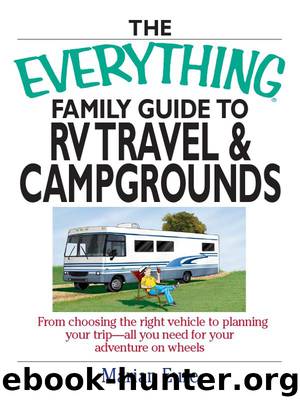The Everything Family Guide To Rv Travel And Campgrounds by Marian Eure

Author:Marian Eure
Language: eng
Format: epub
Tags: ebook, book
Publisher: Adams Media, an imprint of Simon & Schuster, Inc.
Published: 2005-02-01T00:00:00+00:00
Safety First
While it may be tempting to let the kids loose in the RV and stop the whining while traveling, this is very dangerous and against the law. Seat belt and child restraint laws are not just for drivers of cars; RVs are subject to the same laws.
When buying an RV in anticipation of a growing family, be sure to look at the number of seat belts. In newer motorhomes, every seat that can be used while the motorhome is in motion is required by law to have a seat belt. This includes seats at dinettes and couches (even those that turn into beds). Seating that is not anchored to the frame of motorhome is not designed to be used while traveling.
If you are buying used, older motorhomes may not have enough seating with seat belts for your family. Seat belts can often be installed after-market, though it may be expensive.
If you have a large family, there may not even be enough seating, and you may not be able to travel together safely. Keep this in mind when shopping for a motorhome, new or used.
If you have a larger than average family, a travel trailer pulled by a vehicle with adequate seating and restraints may be a better choice.
The typical full-size van or large SUV with three rows of seating can comfortably carry seven to eight passengers with seat belts for all.
FACT
Children under four years of age and less than 40 pounds should be in specially designed car seats while traveling. This is the law in the United States and in Canada. It is the driver’s responsibility to ensure that all passengers under the age of sixteen are protected by safety restraints.
Medical Emergencies
If your child is injured or becomes ill while traveling it can be very scary, especially if you do not know where to go for help. Good maps will often show hospitals where emergency care can be obtained.
Carry a basic first-aid kit in your vehicle or motorhome and check it at least every six months to replace any items that are out-of-date.
Carry a list of poison control centers (you can print one right from the Internet). If you suspect a poison-related incident, call the center closest to your location (from a cell phone or pay phone) for directions on care or information on the nearest emergency care.
Prevent Injury
Take the same precautions in your RV as you would at home:
• Keep poisonous substances out of the reach of children, or in locked cabinets.
• Turn the handles of pots and pans away from the edge to prevent a young child from grabbing one and getting burned.
• Check the temperature of hot water coming from the taps to prevent scalding.
• Do not put young children in upper bunks without bars to keep them from rolling off the edge.
• Watch children closely around swimming pools to prevent drowning.
• Never leave young children alone outside in wilderness areas where wild animals may wander.
FACT
Even young children can learn what to do in case of fire.
Download
This site does not store any files on its server. We only index and link to content provided by other sites. Please contact the content providers to delete copyright contents if any and email us, we'll remove relevant links or contents immediately.
The Inner Game of Tennis by W. Timothy Gallwey(3479)
Unstoppable by Maria Sharapova(3409)
Urban Outlaw by Magnus Walker(3246)
Crazy Is My Superpower by A.J. Mendez Brooks(3208)
Mind Fuck by Manna Francis(3040)
The Social Psychology of Inequality by Unknown(2770)
The Fight by Norman Mailer(2709)
Unstoppable: My Life So Far by Maria Sharapova(2387)
Accepted by Pat Patterson(2219)
Going Long by Editors of Runner's World(2215)
Futebol by Alex Bellos(2138)
The Happy Runner by David Roche(2125)
Motorcycle Man by Kristen Ashley(2116)
Backpacker the Complete Guide to Backpacking by Backpacker Magazine(2111)
The Sports Gene: Inside the Science of Extraordinary Athletic Performance by David Epstein(2064)
Sea Survival Handbook by Keith Colwell(2044)
Peak: Secrets from the New Science of Expertise by Anders Ericsson & Robert Pool(1927)
Endure by Alex Hutchinson(1873)
The Call of Everest by Conrad Anker(1789)
